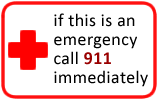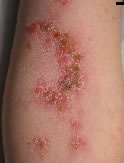Wound Infection
Wound Infection
Does this describe your symptoms? |
Click image for more info |
Definition
Signs of Wound Infection
CA-MRSA: Community Acquired Methicillin-Resistant Staphylococcus aureus
|
If not, see these topics
|
When to Call Your Doctor |
Call Your Doctor Now (night or day) If |
|
|
|
Call Your Doctor Within 24 Hours (between 9 am and 4 pm) If |
|
|
|
Call Your Doctor During Weekday Office Hours If |
|
|
|
Self Care at Home If |
|
|
HOME CARE ADVICE FOR MILD REDNESS OF WOUND |
Warm Soaks or Local Heat: If the wound is open, soak it in warm water or put a warm wet cloth on the wound for 20 minutes 3 times per day. Use a warm saltwater solution containing 2 teaspoons of table salt per quart of water. If the wound is closed, apply a heating pad or warm, moist washcloth to the reddened area for 20 minutes 3 times per day.
Antibiotic Ointment: Apply an antibiotic ointment 3 times a day. If the area could become dirty, cover with a Band-Aid or a clean gauze dressing.
Pain Medicines:
For pain relief, take acetaminophen, ibuprofen, or naproxen.
Acetaminophen (e.g., Tylenol):
Take 650 mg by mouth every 4-6 hours. Each Regular Strength Tylenol pill has 325 mg of acetaminophen.
Another choice is to take 1,000 mg every 8 hours. Each Extra Strength Tylenol pill has 500 mg of acetaminophen.
The most you should take each day is 3,000 mg.
Ibuprofen (e.g., Motrin, Advil):
Take 400 mg by mouth every 6 hours.
Another choice is to take 600 mg by mouth every 8 hours.
Use the lowest amount that makes your pain feel better.
Naproxen (e.g., Aleve):
Take 250-500 mg by mouth every 12 hours.
Use the lowest amount that makes your pain feel better.
Extra Notes:
Acetaminophen is thought to be safer than ibuprofen or naproxen in people over 65 years old. Acetaminophen is in many OTC and prescription medicines. It might be in more than one medicine that you are taking. You need to be careful and not take an overdose. An acetaminophen overdose can hurt the liver.
Caution: Do not take acetaminophen if you have liver disease.
Caution: Do not take ibuprofen or naproxen if you have stomach problems, kidney disease, are pregnant, or have been told by your doctor to avoid this type of medicine. Do not take ibuprofen or naproxen for more than 7 days without consulting your doctor.
Before taking any medicine, read all the instructions on the package
Expected Course: Pain and swelling normally peak on day 2. Any redness should go away by day 3 or 4. Complete healing should occur by day 10.
Contagiousness: For true wound infections, you can return to work or school after any fever is gone and you have received antibiotics for 24 hours.
Call Your Doctor If:
Wound becomes more tender
Redness starts to spread
Pus, drainage or fever occurs
You become worse
And remember, contact your doctor if you develop any of the "Call Your Doctor" symptoms.
Updated:
March 22, 2017






